Dive Details
Location
Logged dive number
1785
Date
Sunday 31 May 2020
Time
11:46am - 1:56pm
Buddy
Natalia Gale, Cody Sheridan
Seas
Strong current and some surge
Visibility
3 to 8 metres
Duration
130 minutes
Surface interval
Maximum depth
13.1 m
Average depth
10.1 m
Water temperature
17.1°C
Dive Profile from Citizen Hyper Aqualand
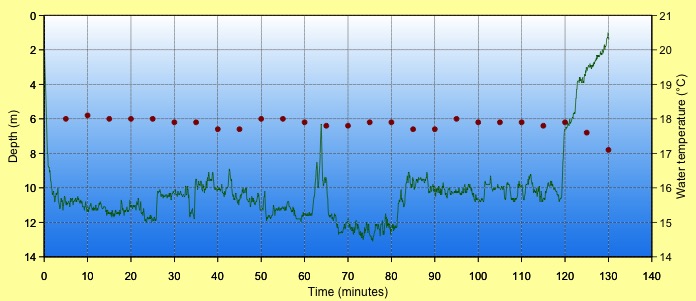
Tides at Botany Bay AEST
Note that tides at dive site may vary from above location.
High
2:42am
1.68m
Low
9:28am
0.45m
High
3:47pm
1.48m
Low
9:35pm
0.70m
Details
Cody and Natalia joined me for today's dive at The Monument. I was keen to see if there had been any impact from last week's rough seas. The Leap and The Steps had faired well and I expected The Monument would, too, but some of the organisms may have been moved on.
We got in at my usual entry point (which people are now calling "Andrew's Entry Point". Cody descended a couple of minutes before us. We descended and headed for the sand line. The visibility seemed to be a little down on yesterday but it was overcast and so hard to tell for sure. It was at least 5 metres and probably closer to 8. The water temperature was between 17 and 18°C. At the sand line there was a fair bit of current but not much surge. There was a lot of loose kelp around and it was difficult to make out the sand line.
We headed towards Sutherland Point. I was keen to find the tiny pink Painted Anglerfish but all the kelp made it difficult to find the right rock. While I was looking I spotted a yellow Red-fingered Anglerfish. I suspect it was the one I'd previously found a little farther along the sand line and it had been moved by the rough seas. I took some photographs and pointed it out to Natalia.
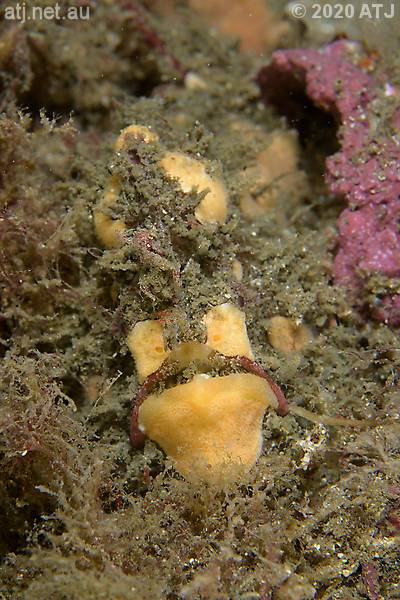
Red-fingered Anglerfish, Porophryne erythrodactylus. 10.7m.
We continued along the sand line and caught up to Cody near Block Rock. I didn't check Block Rock at all and went straight to the rock where Cody had spotted a couple of pygmies on ANZAC Day. After a bit of searching, I found the male (IL2020042502). I took some photographs and pointed it out to Natalia and Cody. I then looked for the female and found her (IL2020042501) on the side of the rock. There was also a Weedy Seadragon swimming near the rock. After I'd finished with the pygmy pipehorses, I took some photographs of the weedy.
I continued along the sand line to Pygmy Playground. I spotted the usual whiteish male pygmy but could not see any others. I pointed it out to Natalia and then swam up to the upper rock to look for the pair that John pointed out a couple of weeks ago.
I found the multi-coloured male and took some photographs but was not able to find the female. I pointed the male out to Natalia.
We drifted along the wall with the current. I looked in the sponges and sea tulips on the wall for seahorses but found none. Near the end of the wall I went up over the wall.
I looked on the rocks near the top of the wall. I spotted a small grey Red-fingered Anglerfish. I wonder if this was the same one I'd spotted a month or so ago in the same area. I took some photographs and point it out to Natalia and Cody who'd caught up to me.
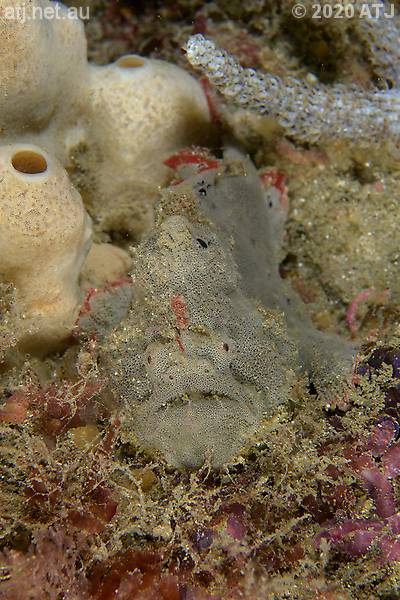
Red-fingered Anglerfish, Porophryne erythrodactylus. 9.9m.
I headed over to the orange sponge where John had pointed out the white pygmy a couple of months ago. I hadn't seen it on the last couple of dives but I always check just in case it was hiding. I didn't see it.
I then checked the flat rock where Cody had found 2 juvenile pygmies a few weeks ago but could not spot them.
We headed along the reef towards Split Rock. I checked the area where I have seen pygmies before and spotted the large orange Red-fingered Anglerfish. It had moved east since (or because of) the rough seas. I pointed it out to Natalia and Cody. I also spotted a small octopus nearby.
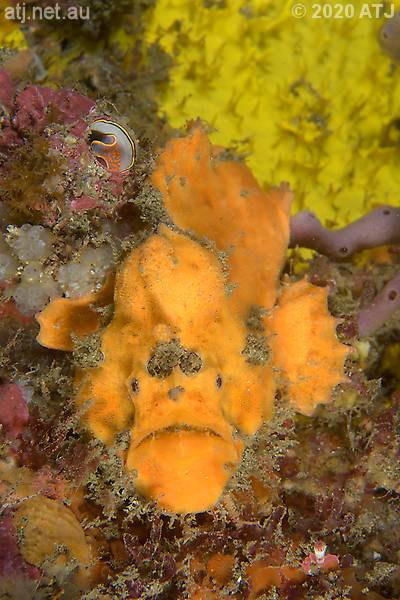
Red-fingered Anglerfish, Porophryne erythrodactylus. 10.6m.
I continued along the reef past Split Rock, pausing to have a look in the sponges. I then swam down to the rock where the orange Red-fingered Anglerfish had been guarding its eggs. I looked above the sponge for Mandy's black Painted Anglerfish and it was still in the same spot it was two weeks ago. I pointed it out to Natalia.
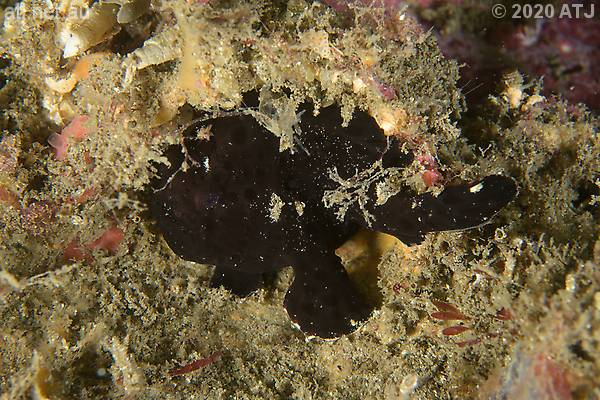
Painted Anglerfish, Antennarius pictus. 11.6m.
I headed to the rock where the large orange Painted Anglerfish has been. Last time we saw it, it was on the western side of the rock but before that it had been on an ascidian colony on the eastern side. I checked the eastern side first and it was back there. I took some photographs and pointed it out to Natalia.

Painted Anglerfish, Antennarius pictus. 11.2m.
I continued along the reef to Four Pygmies Rock (the rock with the single sea tulip). I looked for pygmies but found none but spotted a White's Seahorse. I have seen one on this rock a few times over the last few months but not every time.

Female White's Seahorse, Hippocampus whitei. 11.8m.
I looked on the rock a couple of rocks to the west and spotted the small pygmy that I've seen there for a few weeks.
I had a look on the rock where the well camouflaged anglerfish had had eggs and spotted a large Reaper Cuttlefish.
Natalia indicated she was too cold to go on. We were only an hour into the dive but I understand how cold it can be in a wetsuit. I pointed the way for her to exit and suggested she just follow the terrain. I swam with her to the top of the wall before coming back.
Cody and I continued to Valley of the Pygmies. I looked for pygmies in the valley and on the rock. All I spotted was a Dwarf Lionfish.
We swam along the base of the wall past the three rocks there. I looked for the anglerfish that has been there but did not spot it.
We continued to the boat ladder and I started to look for the seahorse that Alex had told me about. He said it was on a sponge which doesn't really narrow things down. We looked on the three rocks out on the sand but couldn't find it.
We headed up the reef and around the corner to the start of the East-West Wall. On the shelf I found the white female pygmy pipehorse in the Carijoa colony. I looked for a male but could not find one.
We made our way slowly along the base of the wall. I was checking out sponges and sea tulips for seahorses.
I got to the sea tulips where I have been seeing "Jose", the Pot-bellied Seahorse. He's usually in the second sea tulips but today he was in the first ones. I took some photographs and pointed him out to Cody.
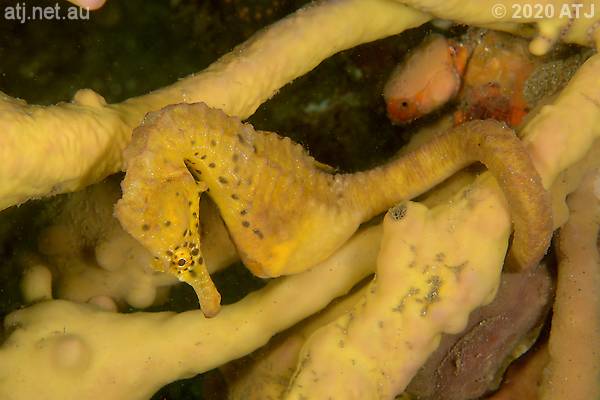
Male Pot-bellied Seahorse, Hippocampus abdominalis, ("Jose"). 10.3m.
We continued to the area where the other seahorse have been. As we approached the area we saw a boat anchor and chain very close to the seahorses. It was almost touching the sponge where I'd seen "Starlight" and another seahorse two weeks ago. I spotted "Starlight" on the sand not all that far from the chain. This could have gone so bad for her.

Female Pot-Bellied Seahorse, Hippocampus abdominalis, ("Starlight"). 10.8m.
I looked for the other seahorses. I spotted "Harry" in the sponge on the main rock. I then found "Tim" and "Sunny" together in the sea tulips. I looked for other seahorse but found none.
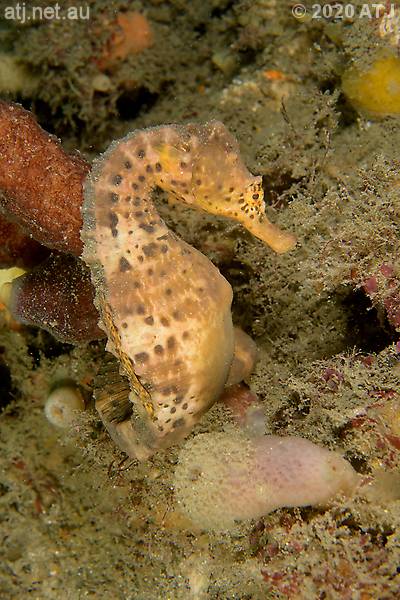
Male Pot-bellied Seahorse, Hippocampus abdominalis, ("Harry"). 9.8m.
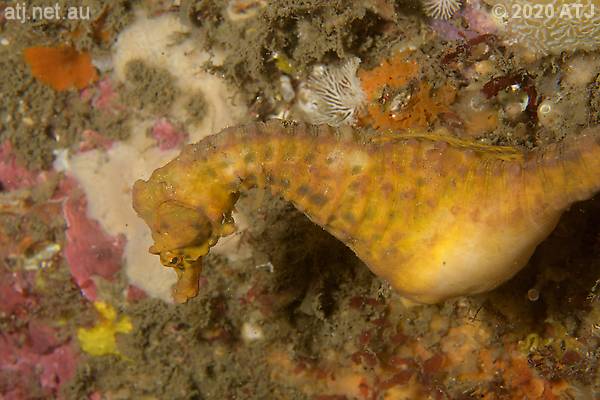
Male Pot-bellied Seahorse, Hippocampus abdominalis, ("Tim"). 10m.

Male Pot-bellied Seahorse, Hippocampus abdominalis, ("Sunny"). 10m.
We continued along the base do the wall and I checked out the finger sponges and sea tulips for seahorses. I found two Dwarf Lionfish.
We followed the base of the wall almost to the end before ascending the wall and swimming south towards the flagpoles. We did our safety stop as we went. I spotted a medium sized flathead on the sand as we went.
We swam until it was too shallow and waded out. I went out through the channel.
Camera gear
Camera
Nikon D500
Lens
Nikon AF-S Micro Nikkor 60mm f/2.8G ED
Housing
Ikelite 6812.5
Lens port
Ikelite Flat Port 5502.41
Strobe(s)
2 x Ikelite SubStrobe DS161